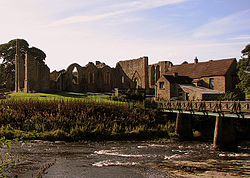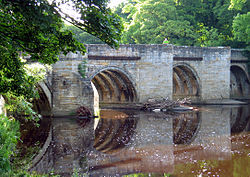River Wear
The Wear is a river in northeast England. It starts in Wearhead, County Durham and opens up into the North Sea at Sunderland.
| River Wear | |
|---|---|
| Length | 96 km (60 mi) |
| Mouth elevation | 0 m (0 ft) |
Industrial past
Much of the River Wear shows the history of the Industrial Revolution. Its upper end runs through lead mining country, until this gives way to coal seams of the Durham coalfield for the rest of its length. As a result of limestone quarrying, lead mining and coal mining, the Wear valley was amongst the first places to see the development of railways. The Weardale Railway continues to run occasional services between Stanhope and Wolsingham.
Geology
The upland area of Upper Weardale has a flora which survives from the end of the last Ice Age. After the Ice Age, the Wear valley became thickly forested. During the Neolithic period and increasingly in the Bronze Age, the forests were progressively cleared for agriculture.
River Wear Media
The wooded riverbanks of the Wear as it flows from Stanhope to Frosterley
The wooded riverbanks of the Wear as it flows through Durham.
Finchale Priory on the banks of the River Wear between Durham and Chester-le-Street.
The Northern Spire before Sunderland City Centre
Croxdale Viaduct carrying the East Coast Main Line
The 1826 stone bridge at Shincliffe
References
- Natural Environment Research Council, Institute of Geological Sciences, 1971, "British Regional Geology: Northern England" Fourth Edition, HMSO, London.
- Johnson, G.A.L. & Hickling, G. (eds.), 1972, "Geology of Durham County", Transactions of the Natural History Society of Northumberland, Durham and Newcastle upon Tyne, Vol.41, No.1.
- 'Wear River', "Encyclopaedia Britannica", 17th Edition, 1990.









